Cats have some of the most diverse eye colours in the entire animal kingdom. But where do they come from? And how come kittens don’t keep their blue eyes? What are the most common eye colours in cats out there?
To find out the answers to all of these questions and much more, check out the in-depth guide on cat eye colours that we have showcased below.
Contents
How cats get their eye colour
Any cat’s colour is directly linked to her genetics.
Melanin is an amino acid that determines how light or how dark a kitten’s eyes will be when she grows up.
That is not the only thing that melanin does, however. The more melanin a cat has, the darker will her coat be.
While all kittens are born with cloudy blue eyes, the colour changes as they grow older. Melanocytes are cells that produce melanin. Therefore, a cat that has no melanocytes in her eyes will have blue eyes.
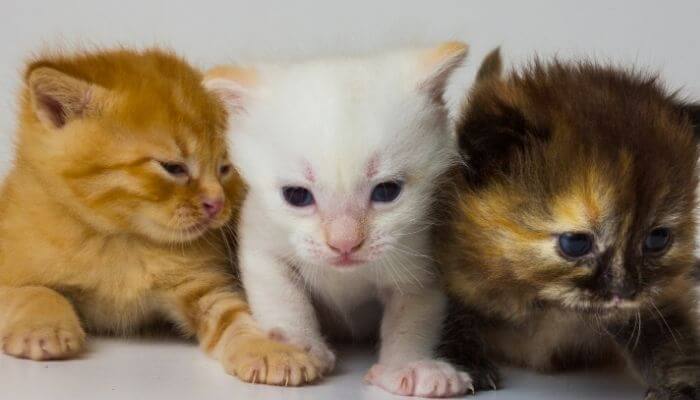
A low number of melanocytes will translate to a green eye colour while a higher number will translate to an orange or amber eye colour.
Depending on how active these cells are, the colour can be lighter or more intense.
For example, if a cat has a low number of melanocytes in her eyes but the cells are not particularly active, her eye colour will be light green.
By contrast, if their activity is more intense, the cat will have dark green eyes.
Different eye colour ranges
A cat’s eye colour is given by the iris as that is the location where the melanocytes responsible for the pigment are situated.
The iris is composed of two layers – the stroma and the epithelium. Each of these has melanocytes, but they are carried differently.
In the stroma, melanocytes are placed in a disorganized manner, but in the epithelium, they are neatly packed.
The eye colour range in cats depends on how these melanocytes are placed in both layers.
There is a wide diversity of colours in our feline friends, especially compared to humans. It’s not uncommon for some cats to have gold eyes, but other common colours include copper, blue, green, yellow, amber, and even red.
Why do kittens’ eyes change colour?
It’s widely known that kittens are born with their eyes closed.
So, until they get to the age of approximately 2 weeks, it is impossible to predict what eye colour they might have.
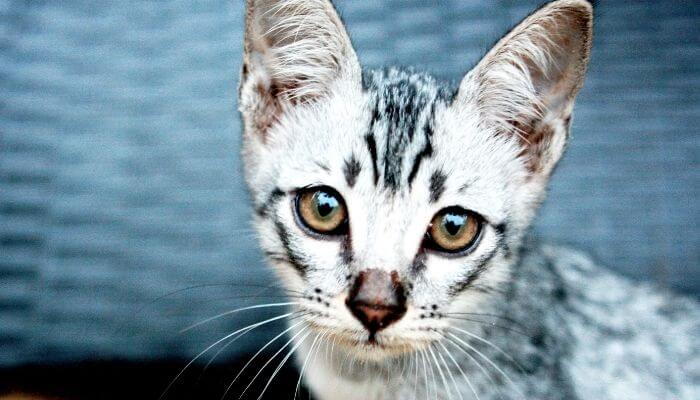
Blue eyes are a standard in young kittens. However, only a very small percentage of all cats retain their blue eye colour as they grow older. They can change into anything from yellow and hazel to a green or golden brown.
This event takes place somewhere around the age of 4 to 10 weeks. So, if you have a kitten that is already 2-months-old and that still has blue eyes, there is a good chance that they will keep their colour.
The reason why this process occurs is that young kittens’ bodies produce very little melanin, but the amount of melanin increases as they become older.
How rare are some eye colours in cats?
The rarest colour, or rather, a colour combination that we can see in cats is a dichromatic feature. This means that, unlike animals that have one eye of a different colour than the other, in this case, there are two colours in the same iris.
Cats can have tiny flecks of different colours in their irises, but in those with dichroic eyes, the iris is half hazel and half green, for example (and very visibly so).
10 Cat Eye Colours
If you want to know more about your cat’s eye colouring, read on to find out about some of the most (and least) common cat eyes colours:
1. Blue
Blue eyes are given by the complete absence of melanin in a cat’s eyes. This feature is genetically transmitted, and it appears more frequently in white cats.
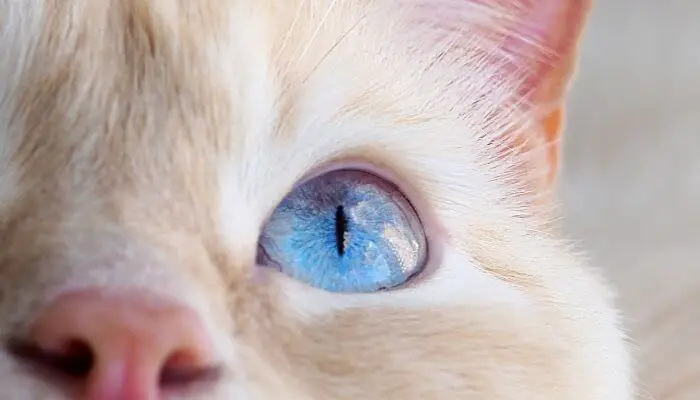
Even though we see the animal’s eyes as blue, the truth is that they are clear. The colour is given by the way the light reflects into the eyes.
This eye colour can be more commonly encountered in certain breeds, such as the following:
- Ragdoll
- Siamese
- British Shorthair
- Persian
- Devon Rex
- Maine Coon
- American Shorthair
A particularity when it comes to blue eyes in cats is the Ojos Azules ‘breed’ from the United States. It has a dominant trait that makes it possible for kittens to retain their deep blue eye colour even when they grow older.
Ojos Azules are prone to dangerous genetic mutations when mated with other blue-eyed cats. This is a fairly recent breed, having been recognised by the International Cat Association in 1991.
An interesting characteristic of Ojos Azules cats is that the eye colour is the only specific feature they have. The coat pattern or coat colour is not directly linked to the eye colour, so kittens can be black and have deep blue eyes, for example.
2. Hazel
Hazel eyes are a result of a combination of golden yellow and green. Considering this eye colour to be common is a mistake as it is usually present in feral cats that live in a temperate climate, but less so in domestic cats.
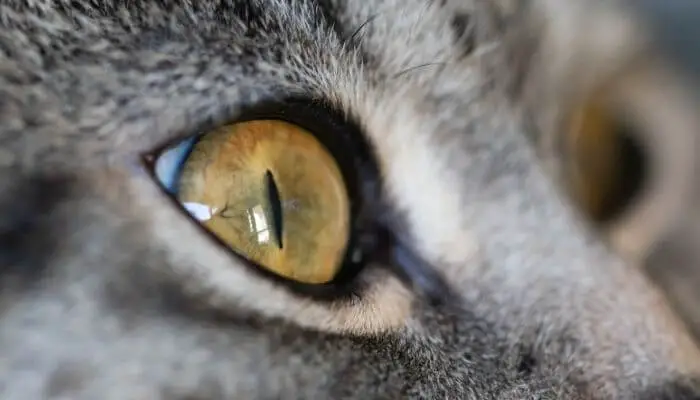
Nevertheless, there are some breeds that are more likely to be born with hazel or brown eyes, such as the Cornish Rex, the Scottish Fold, or the Abyssinian.
3. Green
Green-eyed cats also have a lack of melanin in their eyes. However, compared to their blue counterparts, they at least have some amount.
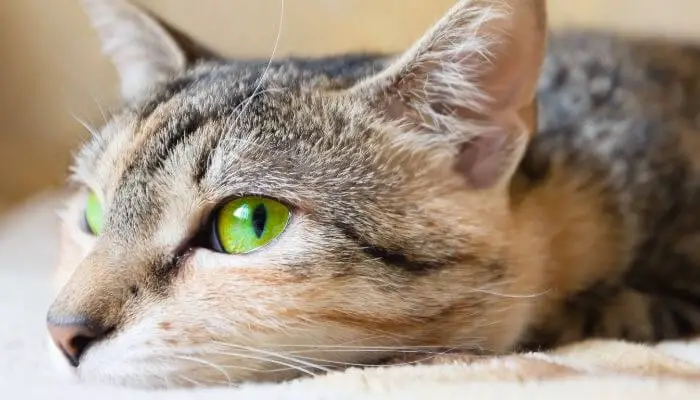
Green eye tones can be found in a very diverse range, from emerald to aqua. In this case, too, there are breeds that are likely to boast specific types of green.
For instance, the Russian Blue has emerald eyes while the Egyptian Mau has gooseberry green eyes. A Chinchilla Persian’s eyes resemble the green of the ocean.
Norwegian Forest Cats can have different tones of green eye colours.
4. Yellow and amber
Golden-eyed cats are among the rarest in the world, but pale lemon and amber are a little more common.
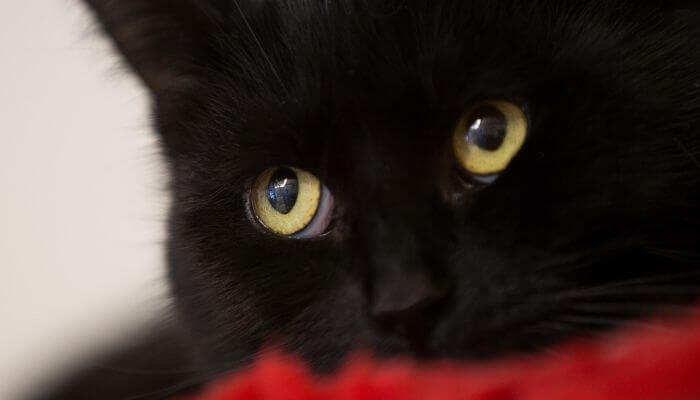
Yellow and amber eye colours can be encountered in breeds such as the British Shorthair, the Norwegian Forest Cat, or the Bombay.
5. Copper
This is perhaps the darkest eye colour that cats can have. It is given by a higher amount of melanin in their eyes, in both layers of the iris.
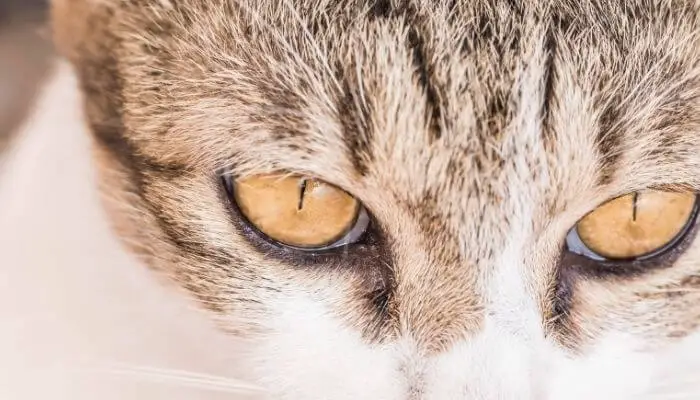
Like pure orange-eyed cats, copper-eyed ones can be rare. However, those whose eyes also have traces of yellow, amber, or even green are less unusual.
Copper is an eye colour that can be encountered in many breeds, from the Persian to the Chartreux and the Cornish Rex.
6. Orange
The orange eye colour can be seen in specific breeds, and that is because British breeders used this feature for mating in their catteries.
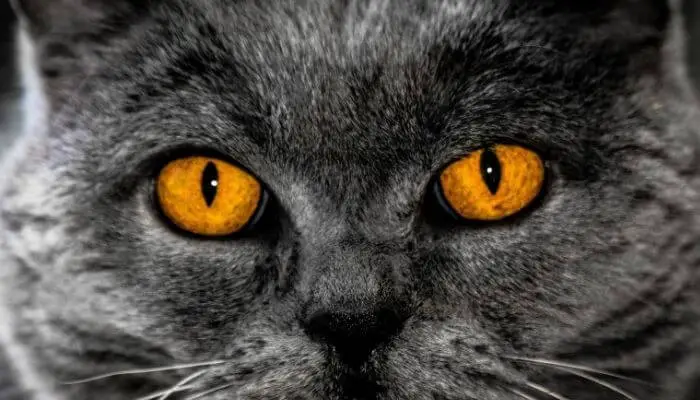
A pure orange-eyed cat might be more difficult to find, but some that have flecks of yellow in their orange irises or those that have a ring of yellow outside their orange irises are more prevalent.
This eye colour can be seen in breeds such as the following:
- Devon Rex
- Maine Coon
- Turkish Van
- Japanese Bobtail
7. Lilac
This colour is present in albino cats. Albinism is a result of poor breeding, and it seems to affect the Siamese and Oriental breeds more than the others.
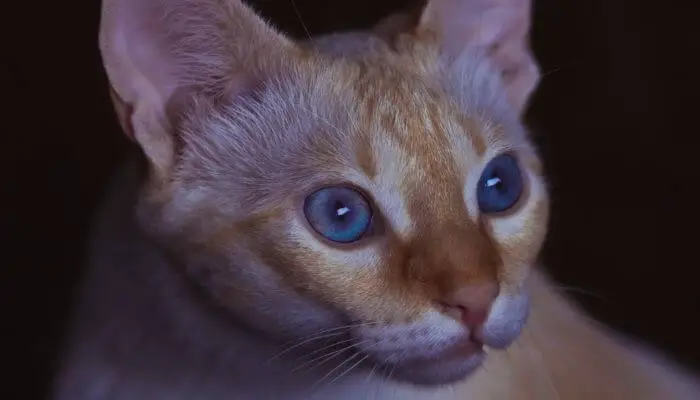
A cat with lilac-blue eyes will often have a rose or red pupil. The absence of melanin in both of the layers of the iris, as well as the particularities of the pupil, make these cats photosensitive.
8. Pink
This is a pathological colour, not a normal one. It is a result of an under-pigmented retina, as well as a too pale iris. The eye colour can be seen in smoke-blue Persians and other pale-coloured cats that have the Chediak-Higashi Syndrome.
Pets that have this disease often develop cataracts by the time they are three months of age. Furthermore, they are likely to suffer from increased bleeding as their platelets do not function normally.
Since Chediak-Higashi Persians are also likely to have a poor immune response, they can develop infections more frequently than cats with a perfectly functioning immune system.
9. Heterochromic eyes
Cats that have heterochromia have odd-coloured irises. Heterochromia can be inherited or congenital (with the latter being a defect). Furthermore, it can be acquired and even caused by trauma, disease, or certain medications.
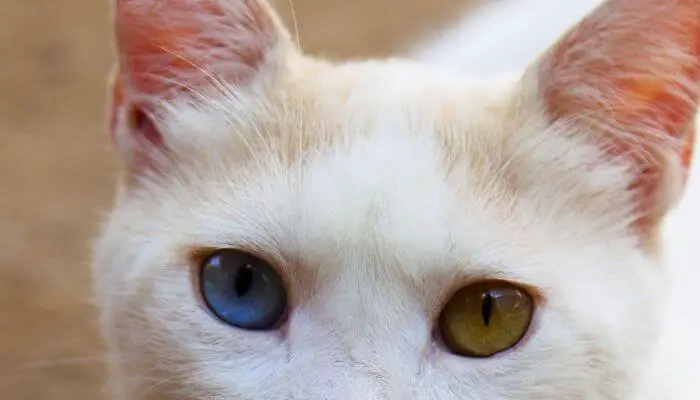
A blue eye is more common in cats with odd eyes. The other can be anything from yellow and green to brown or amber. Interestingly enough, there are even pedigree odd-eyed cats, who always have a blue eye and an orange or amber one.
The heterochromic feature is more frequently seen in cats that have a completely white coat or at least several large, white patches on their bodies. While heterochromia can be found in other coloured cats, it’s far rarer by comparison.
10. Dichroic eyes
Dichromatic eyes are partially heterochromatic, meaning that there are two colours present in the same iris. There are cats that have both of their eyes dichroic, but there are also some with just one dichroic eye.
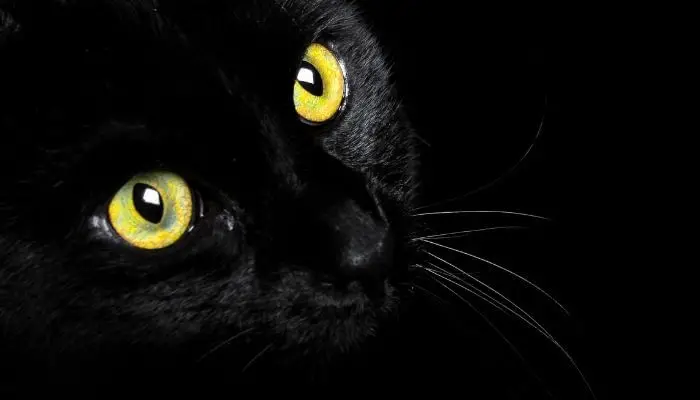
Some animals might have half of their iris of a different colour than the other. The most common dichromia is, in fact, manifested in the form of a ring around the pupil.
For instance, the cat might have a yellow ring around a brown or green iris.
Deafness and blue eyes
It’s estimated that approximately 10 to 20% of cats that have blue eyes are likely to be deaf.
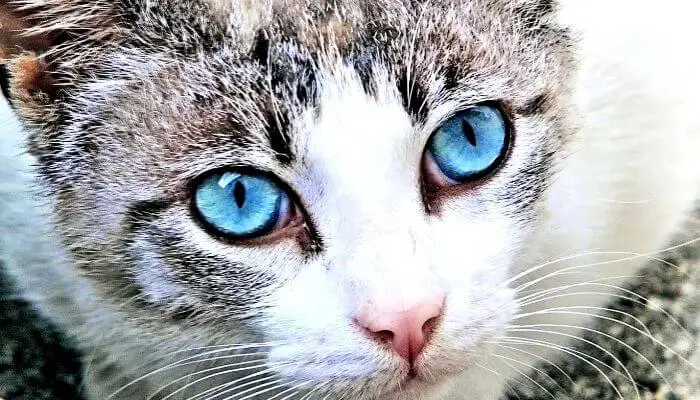
However, white cats are the exception.
In their case, one or two blue irises can significantly increase their chances of being deaf. For instance, if a white cat has just one blue eye, it is estimated that she is likely to be around 40% deaf.
The location of the blue eye also has a say when it comes to her specific deafness. If her left eye is blue, the chances of her being partly or completely deaf in her left ear are high.
White cats whose eyes are both blue are said to be 65 to 85% deaf. Some can be deaf in one ear, but others can be in both. White cats with blue eyes can also be photophobic or have a poorer vision in low-light conditions.
Abnormal eye colour changes
The main eye colour of a cat is given by the iris, but it can also be given by the adjacent layers of the organ, such as the conjunctiva, the pupil, the sclera, and others.
Abnormal eye colour modifications appear in certain illnesses, and while they usually don’t affect the entire iris colour, they can lead to changes and convince a pet guardian that it might be time to go to the vet.
Ask a Vet
If you are concerned about a recent change in your cat’s eye colour we recommend you speak with a vet ASAP. JustAnswer allows you to talk in real-time to veterinary experts for a small fee.
In the section below, we have described some of the most common medical conditions that can affect the entire eye colour as one of their symptoms.
Iris melanosis and iris melanoma
As its name suggests, this disease affects the iris, so it directly influences a cat’s eye colour. There is a significant difference between the two conditions.
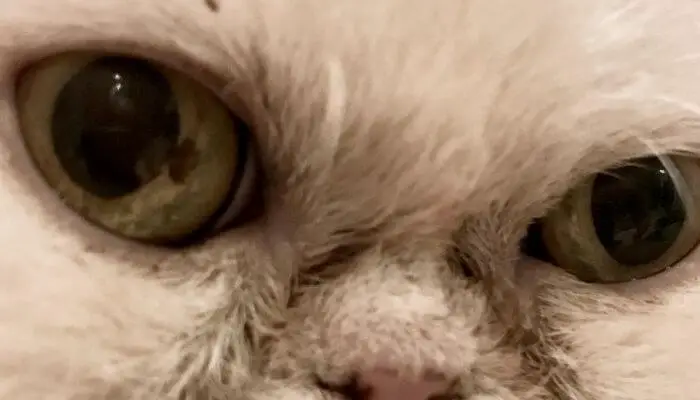
While both melanosis and melanoma are types of cancer, the first is benign and the second is malignant.
Melanosis cases usually don’t call for any treatment, as the golden or brown spots in the iris stop developing at one point.
On the other hand, iris melanoma is one of the most severe diseases that cats can suffer from. Moreover, to date, there is no therapy more effective than removing the eye in its entirety — and this works only if the cancer hasn’t already spread.
If the tumour has not yet metastasised, the eye will be removed. Many cats can go back to their regular lives after the procedure was performed, but they will have to be taken to the vet clinic for regular screening to make sure that the other eye remains healthy.
Cataracts
This condition mostly affects geriatric cats. However, it can also appear in younger individuals who suffer from diabetes, hypertension, or who have been exposed to certain medications or toxic substances.
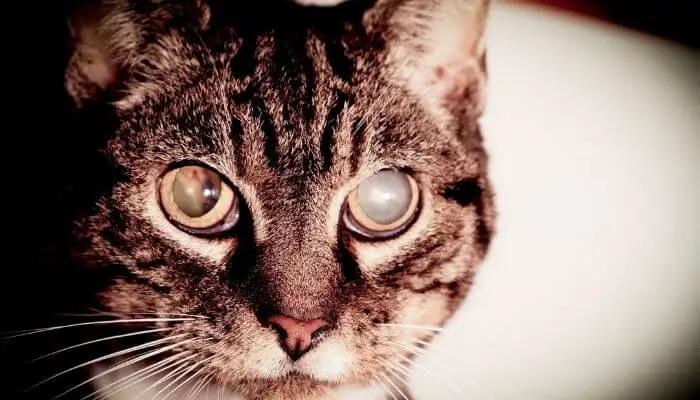
What is the most noticeable in cats with cataracts is a sort of cloudiness over the iris, which makes it impossible for pet parents to discern the same eye colour as usual.
When left untreated, cataracts can lead to blindness, so it is of utmost importance that you take your pet to the vet as soon as possible. With the appropriate therapy, the process can be slowed down so that the cat retains most of her vision.
Glaucoma
Glaucoma is a condition where the pressure inside the eye increases to the point that it can destroy it completely.
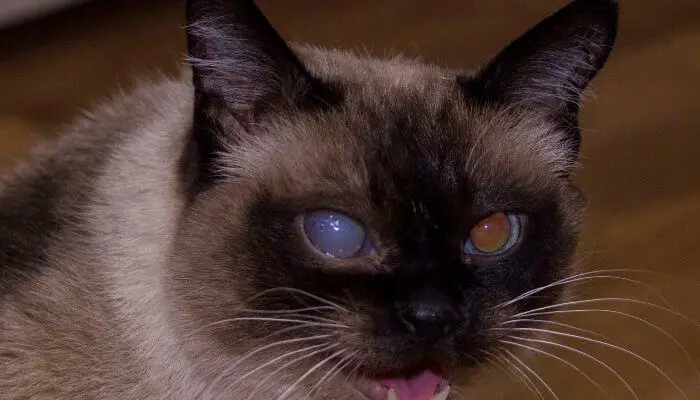
There are two types of glaucoma – primary and secondary. The primary variant shows up in Burmese and Siamese cats more frequently than in other breeds, and it is caused by an abnormally developed eye.
Secondary glaucoma can appear as a result of trauma, lens damage, intr-ocular bleeding, and other such causes.
When it comes to its symptoms, glaucoma causes a cloudy or blue cornea (the part of the eye that sits right on its surface). So, the colour can show up either right above the iris or in the white part of the cat’s eye.
Another very visible clinical sign is intense eye inflammation. The cat can be in pain and have ocular discharge. Acute glaucoma can lead to blindness, so immediate veterinary assistance is necessary.
Eye infections
The most common eye infection that a cat can get is conjunctivitis, although there are others, more complicated ones.
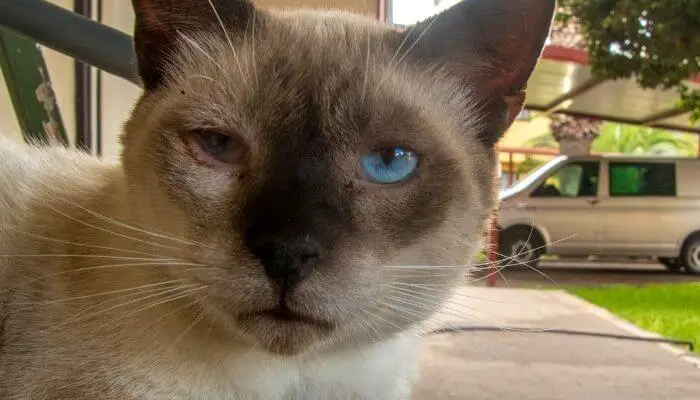
If your cat has conjunctivitis (also known as pink eye), you will notice a colour change in the eye edges. The conjunctival membranes appear to be swollen and red.
In an attempt to soothe the pain and the constant discharge (which can be watery, yellow, or green), most pets will rub their eyes.
Unfortunately, this only seems to complicate matters further as a cat can often add bacteria to the germs that have already caused the eye infection.
Jaundice
This is a disease that can be difficult to diagnose in cats that have naturally darker gums or skin. However, in its more severe stages, it is discernible in the white part of the eyes (the sclerae), the gums, and the ear flaps.
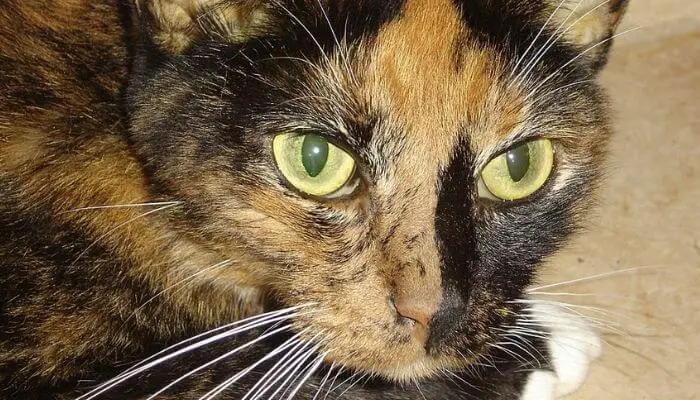
Jaundice can be caused by anything from blood parasites to liver disease, hemolysis (destruction of red blood cells), or viral and bacterial infections.
Depending on the disease that has caused it, icterus (jaundice) can be easier or harder to treat in cats.
Blood in the front of the eye in cats
Hyphema typically occurs due to severe eye diseases (retinal dysplasia, severe uveitis, retinal tearing or detachment, and glaucoma) or conditions such as hyperthyroidism, hypertension, or blood clotting disorders.
This is a symptom, not a disease, and it clinically appears in the form of red or reddish spots in the iris. If you notice this in your pet, go to the vet as soon as possible.
Ask a Vet
If you are concerned about a recent change in your cat’s eye colour we recommend you speak with a vet ASAP. JustAnswer allows you to talk in real-time to veterinary experts for a small fee.
What colours do cats see?
Now that we have looked at what eye colours cats can have, you might want to know just how cats see the world compared to humans.
First of all, cats have a slightly wider field of view than that of people. Instead of 180 degrees, they see 200 degrees, which means that they are equipped with excellent side vision.
Compared to dogs, cats see a wider range of colours, but the tones are fainter than in human vision. For example, a spring landscape would look like an autumn landscape to a cat’s eyes.
Another aspect that makes the difference between cat vision and human vision is the ability to see at night. It is widely known that cats are excellent hunters and while this is also due to their superior sense of hearing, it is also due to their outstanding night vision.
A cat’s eyes are equipped with a higher number of specialised cells (called rods) that enable her to see better in the dark. On the other hand, people can see better than cats in bright light.
In summary
A cat’s eye colour is caused by the presence and activity of melanin in her body, which can only be the result of genetics.
Cat eyes come in a broad range of colours, and while most of them are perfectly normal, some, such as pink, can be alarming and an indication of certain health issues.
Keeping your cat’s vision in perfect health is essential, especially if she spends a lot of time outdoors. A cat that loses her sight will also lose her ability to properly defend herself from potential predators or more modern dangers, such as cars.
With the appropriate care, your cat can keep her sight in perfect shape for as long as she lives.
As an Amazon Associate I may earn a small fee from qualifying purchases at no extra cost to you. This helps us run the site, so thanks for your support!

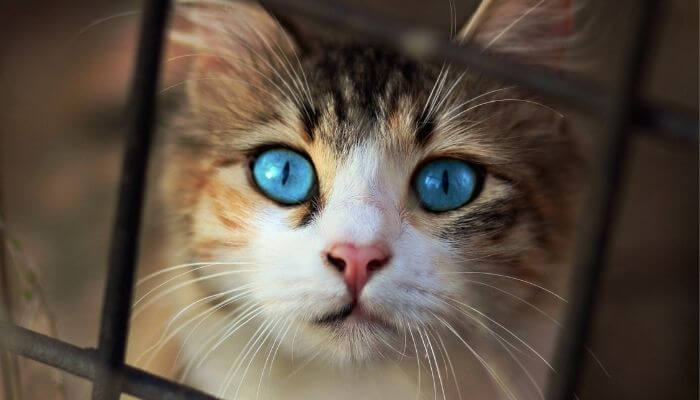
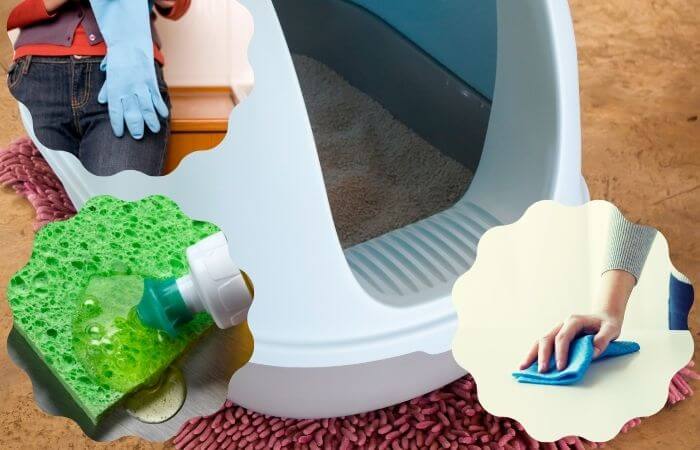

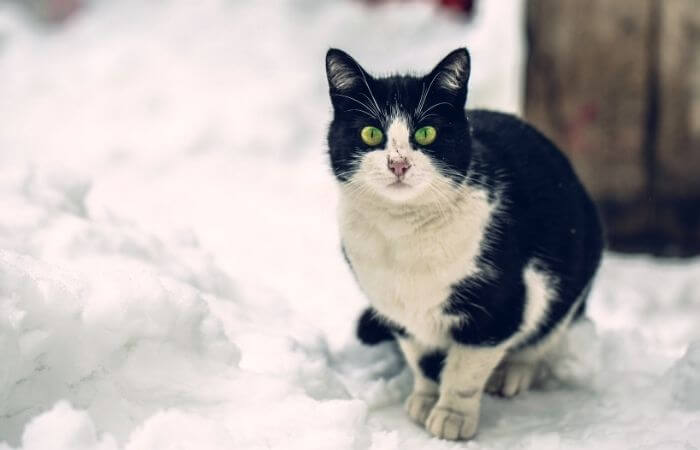
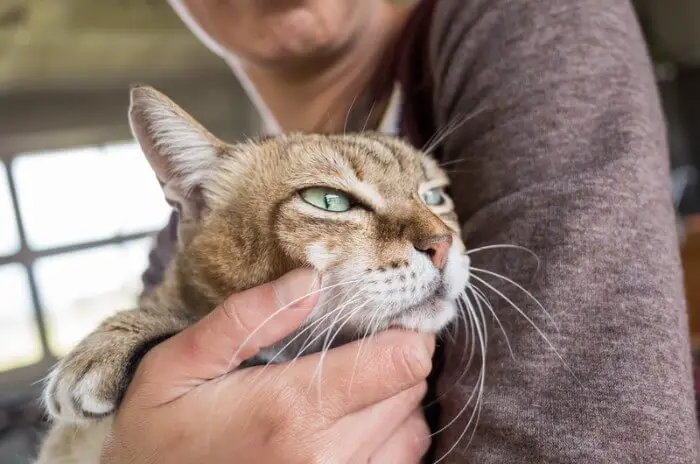
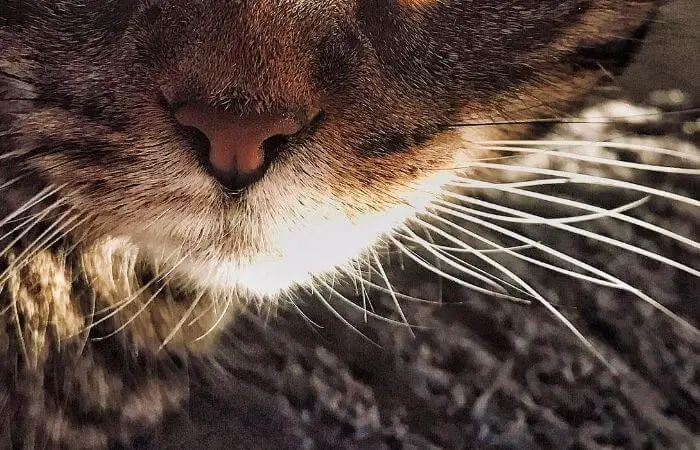

Leave a Comment